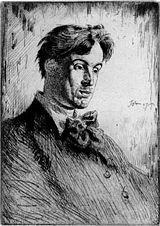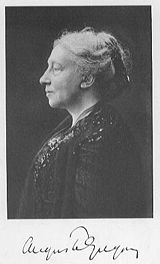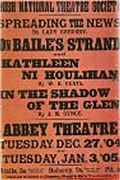Abbey Theatre
2008/9 Schools Wikipedia Selection. Related subjects: Theatre
| Abbey Theatre | |
 |
|
| Front facade | |
|---|---|
| Address |
26 Lower Abbey Street
|
| City | |
| Country | Ireland |
| Designation | National Theatre of Ireland |
| Architect | Michael Scott |
| Owned by | Abbey Theatre Limited (prev. National Theatre Society) |
| Capacity | 494 |
| Opened | 1904 |
| Rebuilt | 1965 |
| abbeytheatre.ie | |
The Abbey Theatre ( Irish: Amharclann na Mainistreach), also known as the National Theatre of Ireland ( Irish: Amharclann Náisiúnta na hÉireann), is in Dublin, Ireland. The Abbey first opened its doors to the public on 27 December 1904, and despite losing its original building to a fire in 1951 has remained active to the present day. The Abbey was the first state-subsidised theatre in the English-speaking world; from 1925 onwards it received an annual subsidy from the Irish Free State.
In its early years, the theatre was closely associated with the writers of the Celtic revival, many of whom were involved in its foundation and most of whom had plays staged there. The Abbey served as a nursery for many of the leading Irish playwrights and actors of the 20th century, including William Butler Yeats, Lady Gregory Augusta, Sean O'Casey and John Millington Synge. In addition, through its extensive programme of touring abroad and its high visibility to foreign, particularly North American, audiences, it has become an important part of the Irish tourist industry.
Before the Abbey
The Abbey arose from three distinct bases, the first of which was the seminal Irish Literary Theatre. Founded by Lady Gregory, Edward Martyn and William Butler Yeats in 1899—with assistance from George Moore—it had presented plays in the Ancient Concert Rooms and the Gaiety Theatre, which brought critical approval but limited public interest.
The second base involved the work of two Irish brothers, William and Frank Fay. William worked in the 1890s with a touring company in Ireland, Scotland and Wales while Frank was heavily involved in amateur dramatics in Dublin. After William returned, the brothers staged productions in halls around the city and eventually formed W. G. Fay's Irish National Dramatic Company, focused on the development of Irish acting talent. In April 1902, the Fays gave three performances of Æ's play Deirdre and Yeats' Cathleen Ní Houlihan in a hall in St Theresa's Hall on Clarendon Street. The performances played to a mainly working-class audience rather than the usual middle-class Dublin theatre-goers. The run was a great success, thanks in part to Maud Gonne, who played the lead in Yeats' play. The company continued at the Ancient Concert Rooms, producing works by Seumas O'Cuisin, Fred Ryan and Yeats.
The third base was the presence in Dublin of Annie Elizabeth Fredericka Horniman. Horniman was a middle-class Englishwoman with previous experience of theatre production, having been involved in the presentation of George Bernard Shaw's Arms and the Man in London in 1894. She came to Dublin in 1903 to act as Yeats' unpaid secretary and to make costumes for a production of his play The King's Threshold. Her money would make the Abbey Theatre a viable reality, and according to the critic Adrian Frazier, would "make the rich feel at home, and the poor - on a first visit - out of place."
Foundation
Encouraged by the St Theresa's Hall success, Yeats, Lady Gregory, Æ, Martyn, and John Millington Synge founded the Irish National Theatre Society in 1903 with funding from Horniman. At first, performances were staged in the Molesworth Hall. When the Hibernian Theatre of Varieties in Lower Abbey Street and an adjacent building in Marlborough Street became available after fire safety authorities closed the Hibernia, Horniman and William Fay agreed to buy and refit the space to meet the society's needs. On 11 May 1904, the society formally accepted Horniman's offer of the use of the building. As Horniman was not normally resident in Ireland, the royal letters patent required were paid for by her but granted in the name of Lady Gregory. William Fay was appointed theatre manager, responsible for training the actors in the newly established repertory company. Yeats' brother Jack was commissioned to paint portraits of all the leading figures in the society for the foyer, while Sarah Purser was hired to design stained glass for the same space.
On 27 December, the curtains went up on opening night. The bill consisted of three one-act plays, On Baile's Strand and Cathleen Ní Houlihan by Yeats, and Spreading the News by Lady Gregory. On the second night, In the Shadow of the Glen by Synge replaced the second Yeats play, and these two bills alternated over a five-night run. Frank Fay, playing Cúchulainn in On Baile's Strand, was the first actor on the Abbey stage. Although Horniman had designed the costumes, neither she nor Lady Gregory were present. Horniman had, in fact, returned to England, and her main role with the Abbey over the coming years, in addition to providing funding, was to organise publicity and bookings for touring Abbey productions in London and provincial England.
In 1905, Yeats, Lady Gregory and Synge decided to turn the theatre into a limited liability company, the National Theatre Society Ltd., without properly consulting Horniman. Annoyed by this treatment, she hired Ben Iden Payne, a former Abbey employee, to help run her new repertory company in Manchester.
Early years
The new theatre found great popular success, and large crowds attended many of its productions. The Abbey was fortunate in having Synge as a key member as he was then considered one of the foremost English-language dramatists. The theatre staged many plays by eminent or soon-to-be eminent authors, including Yeats, Lady Gregory, Moore, Martyn, Padraic Colum, George Bernard Shaw, Oliver St John Gogarty, F. R. Higgins, Thomas MacDonagh, Lord Dunsany, T. C. Murray, James Cousins and Lennox Robinson. Many of these authors served on the board, and it was during this time that the Abbey gained its reputation as a writers' theatre.
The Abbey's fortunes worsened in January 1907 when the opening of Synge's The Playboy of the Western World resulted in civil disturbance. The troubles (since known as the Playboy Riots) were encouraged, in part, by nationalists who believed the theatre was insufficiently political and who took offence at Synge's use of the word ' shift'—known at the time as a symbol representing Kitty O'Shea and adultery and hence seen as a slight on the virtue of Irish womanhood. A significant portion of the crowd rioted, causing the remainder of the play to be acted out in dumbshow. Nationalist anger was further provoked by the theatre's decision to call in the police. Although press opinion soon turned against the rioters and the protests faded, the Abbey was shaken, and Synge's next—and last completed—play, The Tinker's Wedding (1908), was not staged for fear of further disturbances. That same year, the Fay brothers' association with the theatre ended when they emigrated to the United States and Lennox Robinson took over the Abbey's day-to-day management.
In 1909, Shaw's The Shewing-Up of Blanco Posnet led to further protests. The subsequent discussion occupied a full issue of the theatre's journal, "The Arrow". Also that year, the proprietors decided to make the Abbey independent of Annie Horniman, who had indicated a preference for this course. Relations with Horniman had been tense, partly because she wished to be involved in choosing which plays were to be performed and when. As a mark of respect for the death of King Edward VII, an understanding existed that Dublin theatres were to close on the night of 7 May 1910. Robinson, however, kept the Abbey open. When Horniman heard of Robinson's decision, she severed her connections with the company. By her own estimate, she had invested £10,350—worth approximately $1 million in 2007 US dollars—on the project.
With the loss of Horniman, Synge, and the Fays, the Abbey under Robinson tended to drift, suffering from falling public interest and box office returns. This trend was halted for a time by the emergence of Sean O'Casey as an heir to Synge. O'Casey's career as a dramatist began with The Shadow of a Gunman, staged by the Abbey in 1923. This was followed by Juno and the Paycock in 1924, and The Plough and the Stars in 1926. This last play resulted in riots reminiscent of those that had greeted the Playboy 19 years earlier. Once again, concerned about public reaction, the Abbey rejected O'Casey's next play, and he emigrated to England shortly thereafter.
In 1924, Yeats and Lady Gregory offered the Abbey to the government of the Free State as a gift to the Irish people. Although the offer was refused, the following year Minister of Finance Ernest Blythe arranged an annual government subsidy of £850 for the Abbey. This made the company the first state-supported theatre in the English-speaking world. The subsidy allowed the theatre to avoid bankruptcy, but the amount was too small to save it from financial difficulty.
The Abbey School of Acting and the Abbey School of Ballet were set up that year. The latter was led by Ninette de Valois—who had provided choreography for a number of Yeats' plays—and ran until 1933.
Around this time additional space was acquired, allowing for a small experimental theatre, the Peacock, to be set up in the ground floor of the main theatre. In 1928, Hilton Edwards and Micheál MacLiammoir launched the Gate Theatre, initially using the Peacock to stage works by European and American dramatists. However, the Gate primarily sought work from new Irish playwrights, and despite the new space, the Abbey entered a period of artistic decline. This is illustrated by the story of how one new work was said to have come to the theatre. Denis Johnston, the story goes, submitted his first play, Shadowdance, to the Abbey; however it was rejected by Lady Gregory and returned to the author with “The Old Lady says No” written across the title page. Johnston decided to re-title the play, and The Old Lady Says 'No' was staged by the Gate in the Peacock in 1928. The veracity of this story has been questioned by academic critics Joseph Ronsley and Christine St. Peter.
After Yeats
The tradition of the Abbey as primarily a writers' theatre survived Yeats' withdrawal from day-to-day involvement. Frank O'Connor sat on the board from 1935 to 1939, served as managing director from 1937, and had two plays staged during this period. However he was alienated from and unable to cope with many of the other board members. O'Connor's past adultery was held against him, and although he fought a formidable battle to retain his position, soon after Yeats died machinations were put in place to remove him.
During the 1940s and 1950s, the staple fare at the Abbey was comic farce set in the idealised peasant world of Éamon de Valera, which, if it ever existed, no longer was relevant to most Irish citizens. As a result, audience numbers continued to decline. This drift might have been more dramatic but for the appearance of popular actors including F. J. McCormick and dramatists including George Shiels, who could still draw a crowd. Another Abbey tenant was Austin Clarke, whose Dublin Verse Speaking Society—later the Lyric Theatre—operated out of the Peacock from 1941 to 1944 and the Abbey from 1944 to 1951.
On 17 July 1951, fire destroyed the building, and only the Peacock survived intact. The company leased the old Queen's Theatre in September and continued in residence there until 1966. The Queen's had been home to the Happy Gang, a team of comedians who specialised in popular skits, farces and pantomimes and drew wide audiences. With its continued diet of 'peasant comedies', the new tenants were not far removed from the old. However neither of the two more interesting Irish dramatists to emerge in the 1950s, Brendan Behan and Samuel Beckett, featured in these productions. In February 1961, the ruins of the Abbey were demolished, and plans for rebuilding began with a design by the Irish architect Michael Scott. On 3 September 1963, the President of Ireland, Eamon de Valera, laid the foundation stone for the new theatre. The Abbey reopened on 18 July 1966.
1966–2005
A new building, a new generation of dramatists including such figures as Hugh Leonard, Brian Friel and Tom Murphy, and tourism that included the National Theatre as a key cultural attraction helped revive the theatre. Aiding the revival was the theatre's involvement, beginning in 1957, in the Dublin Theatre Festival. Plays such as Friel's Philadelphia Here I Come! (1964), The Faith Healer (1979) and Dancing at Lughnasa (1990), Murphy's A Whistle In the Dark (1961) and The Gigli Concert (1983) and Leonard's Da (1973) and A Life (1980) helped raise the Abbey's international profile through successful runs in the West End in London, and on Broadway in New York.
In December 2004, the theatre celebrated its centenary with events that included performances of the original programme by amateur dramatic groups and the professional premiere of Michael West's Dublin By Lamplight, staged by Annie Ryan for The Corn Exchange company at the Project Arts Centre in November 2004. However, despite the centenary, not all was well. Audience numbers were falling; the Peacock was closed for lack of money; the theatre was near bankruptcy, and the staff felt the threat of huge lay-offs. In September a motion of no confidence in Artistic Director Ben Barnes was tabled by two members, playwrights Jimmy Murphy and Ulick O'Connor, of the theatre's advisory council. Barnes, criticised for touring with a play in Australia during deep financial and artistic crisis at home, flew back and survived the motion. The debacle put the Abbey under great public scrutiny. On 12 May 2005, Barnes and Managing Director Brian Jackson resigned after it became known that the theatre's deficit of €1.85 million had been underestimated. The new director, Fiach Mac Conghail, who had been due to start in January 2006, took over in May 2005.
Recent years
On 20 August 2005, the Abbey Theatre Advisory Council approved a plan to dissolve the Abbey's owner, the National Theatre Society, and replaced it with a company limited by guarantee, the Abbey Theatre Limited. After strong debate the program was accepted. Basing its actions on this plan, the Arts Council of Ireland awarded the Abbey €25.7 million in January 2006 to be spread over three years. The grant represented an approximate 43 percent increase in the Abbey's revenues and was the largest grant ever awarded by the Arts Council. The new company was established on 1 February 2006, with the announcement of a new Abbey Board chaired by High Court Judge Bryan McMahon. In March 2007, the larger auditorium in the theatre was radically reconfigured by Jean-Guy Lecat as part of a larger upgrading of the theatre.
More than 20 writers have been under commission by the Abbey since Mac Conghail was appointed director in May 2005. A developing trend is for the Abbey to produce new Irish plays commissioned and developed by London's Royal Court theatre; Tom Murphy's Alice Trilogy and Marina Carr's Woman and Scarecrow are examples.
Plans
After discussions over many years, the Irish government announced in 2007 that a new theatre building would be procured for the Abbey by way of a public-private partnership contract for design, construction, financing and maintenance. This building will be in Dublin's "Docklands" area and will comprise three auditorium spaces, including a 700-seat main theatre, a 350-seat secondary performance space and a 150-seat studio theatre, along with rehearsal and education facilities, storage, wardrobe, archive and office space, and one or more bars and restaurants and a bookshop. The general and artistic operation of the new theatre will continue to be the responsibility of the Abbey Theatre Amharclann na Mainistreach Ltd.



